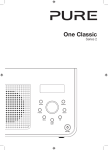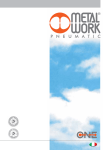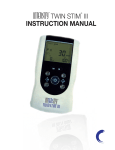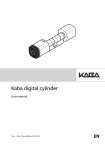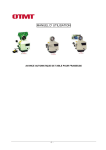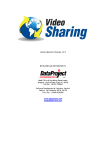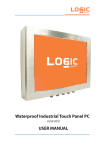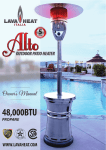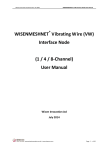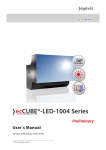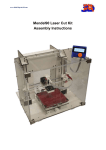Download USE AND MAINTENANCE
Transcript
USE AND MAINTENANCE HOW TO USE FIXING There are three possible: 1. At the front, with M5x75 screws. The supply includes: 2 screws M5x75 2 washers 5x10 2 nuts M5 2. At the rear, with M6x70 screws The supply includes: 2 screws M6x70 2 washers 6x12,5 (the M6 nuts are included in the group) 10 MAX 3. Panel In this case the kit of “panel mounting brackets” must be purchased Code 9200702 10 MAX FLUID ONE has been designed to treat compressed air. No other fluid can be used without express authorisation by Metal Work. It is preferable to use UNLUBRICATED air. If there are devices requiring lubrication, it is advisable to install the lubricator downstream ONE as close as possible to the devices involved. NO YES THREADED PORT CONNECTION Connect the ports to the thread by rotating the fitting or ONE’s rotary threaded port as most appropriate (A). Do not subject the unit to transversal stresses or tilting torques that may damage it (B). A B 1 SUPPLEMENTARY AIR INTAKES A - Non-regulated filtered air intake This is a 1/4” port situated at the top on the left that takes air downstream of the filter before the regulator and the valves, pressure switches, etc. It is used for example for a compressed air gun. To use it, remove the A7 plug. NB: Switch off the compressed air supply before removing the plug. If there is no alternative method, unscrew the filter plug, the automatic valve incorporated in the unit will cut off air flow after the filter. A G1/4” B G1/4” B – Regulated filtered air intakes There is a 1/4” port at the top on the right and one bottom right, connected in parallel the main threaded outlet port, so downstream of the regulator, the valves, the pressure switch and so on. To use it, remove the A7 plug. NB: Switch off the compressed air supply before removing the plug. Merely turn the manual V3V valve, if there is one, to off, or switch off the electricity supply to any solenoid valves. If there is no alternative method, unscrew the filter plug, the automatic valve incorporated in the unit will cut off air flow after the filter. B G1/4” CONDENSATE DRAIN An efficient internal system separates most of the water condensate in the compressed air and collects it in a clear bowl at the bottom of the unit. This water has to be drained out. If an RMSA device is present, the compressed air supply must be switched off periodically to drain out the condensate or, alternatively, the ring nut must be pushed upwards by hand. If there is an automatic drain, the condensate is drained out automatically whenever the level in the bowl reaches the point of intervention of the float valve. If you wish to drain the water out elsewhere, attach a 1/8” pipe and fitting. NB: If the diameter of the pipe is too small, or there are bends or bottlenecks, it is difficult for the water to flow through it and the automatic drain does not work properly. RMSA The semi-auto condensate drain is the normally open type. When there is pressure in the bowl, the drain closes. When there is no pressure in the bowl, it opens and the condensate drains out. If necessary, it is possible to drain the condensate whilst the bowl is pressurised. The simple manual operation of “pushing up the valve” will allow the condensate to drain. When rotating the button clockwise, the valve becomes in locked position, and can only work when the button is returned to the central position. RA condensate drain G1/8” AIR EXHAUST One has a single compressed air relief valve at the bottom. Downstream air is discharged when: 1- The V3V manual valve is closed; 2- The V3v electric valve or the APR is switched off; 3- The downstream pressure exceeds the reading on the regulator. The exhaust valve has a 1/4” threaded port supplied standard with a metal mesh silencer. If you wish to convey the air out, replace the silencer with a suitable fitting. A pipe with a diameter of at least 6 mm is recommended. air exaust G1/4” ø at least MIN 6 mm 2 ELECTRICAL CONNECTION A single 5-pin M12x1 connector is used to supply the solenoid valve and handle the pressure switch signals. Even if one of these functions is not present, it is always a 5-pin connector. Only the correct connectors must be connected as shown in the diagrams below. Version with solenoid valve and pressure switch Version with pressure switch 2 (NC) 1 2 (NC) 1 3 (NO) 3 (NO) 4 +24V DC 5 0V DC 4 4 1 5 1 3 Version with solenoid valve 4 +24V DC 5 0V DC 4 1 5 3 2 LEDs The ONE electrical unit always has three LEDs, but only those associated with the current functions are active. - ON : GREEN LED. On if the electric V3V valve or the APR is powered on. - NC : RED LED. Pressure switch’s normally-closed contact. It is on if the actual pressure is lower than the pressure switch setting and if an electrical circuit is connected. - NO : YELLOW LED. Pressure switch’s normally-open contact. It is on if the actual pressure is higher than the pressure switch setting and if an electrical circuit is connected. Leds CLOGGED FILTER SIGNAL 3 3 2 2 If the filter gets so clogged up that it causes an excessive drop in pressure as the air passes through, the orange indicator will project from the body by a few millimetres. It only remains visible while there is effectively a drop in pressure. If for example the required flow rate drops, the indicator will retract. 5 in course of signalling FILTER The filter cartridge is positioned horizontally. To replace it, merely unscrew the plug on the front. The unit contains an automatic on-off valve, so the valve closes automatically when you remove the plug. There is no need for a tap upstream and there is no risk of the plug being blown out. Considering that the air in the cartridge flows outwards, the dirt collects inside the cartridge and does not affect the other internal surfaces. It is always advisable, however, to clean the inside of the unit and the plug. When you replace the plug, tighten it to a maximum torque of 6 Nm, taking care not to damage it. Use an 8-mm Allen wrench if necessary. 5 μm (yellow) 20 μm (white) 8 NO YES PRESSURE REGULATION 1- Turn the knob until you read the desired value on the gauge 2- Then press the knob to lock it. Controlled air relief is provided to improve the pressure regulation. NB: The pressure in standard regulators must always be set upwards. 1 2 V3V MANUAL VALVE When the valve is in the On position, the air supply is enabled. When the valve is in the off position, the air supply is shut off and the air downstream is discharged. If the V3V valve is the padlock type, you can attach the padlock when the valve is on OFF to present it from being rotated. NB: If there is also an electric V3V or APR, the air supply is only enabled if the power supply is on. ON OFF V3V ELECTRIC VALVE When this valve is powered on, the air supply is enabled. When the power supply is switched off, the compressed air supply is cut off and air downstream is relieved. The valve can also be opened without powering it on by pressing the test button. This is a monostable button which returns to the closed position when released. NB: If there is also a manual V3V valve, the air supply is only enabled if it is in the On position. 4 SOFT START VALVE (APR) ONE’s soft start valve is completely new compared to others currently on the market. The pressure is increased gradually whatever the flow rate of the utilities. When the solenoid valve is powered on (if there is an electric soft start valve) or you turn the manual V3V valve to ON (if there is a non-electric soft start valve), the downstream pressure starts to increase. When it reaches about 30-40% of the set value, the valve opens completely and the pressure rises to the set value. The pressure increase can be regulated with precision on the knob on the front. 1- Turn in the “Slow” direction to increase the ramp time. If you rotate as far as it will go, this cuts off the flow of air completely, and the pressure does not increase. 2- Turn in the “Quick” direction to decrease the time it takes to open the valve. If you rotate as far as it will go, the valve will open almost immediately, deactivating the progressive actuator function. After regulation, press the knob to lock it. PRESSURE SWITCH psi bar 140 10 130 9 120 110 High switching pressure The pressure switch has a switching contact, which means you can have a normally-open signal or a normally-close signal. It is also connected to the NC and NO LEDs which come on if the actual pressure is less or greater than the set pressure, respectively. The LEDs only come on if an electric charge (max 0.5 A) is connected to them, as shown in the diagram (see subsection on LEDs). Regulation is by means of the knurled knob. Turn towards “+” to increase the pressure and vice versa. Proceed as follows to make a correct setting. - Turn the knob towards “-“ as far as it will go. - Set on the pressure regulator the value at which you wish the pressure switch to activate and read it on the gauge. The NO LED is on and the NC LED is off. - Turn the knob towards “+” until switching takes place. - Press the knob to lock it. - Reset the desired value for normal operation on the pressure regulator. 100 90 80 8 7 6 70 5 60 4 50 40 3 30 2 20 10 0 1 0 0 1 2 3 4 5 6 7 8 9 10 0 10 20 30 40 50 60 70 80 90 100110120130140 Low switching pressure SECURITY KNOB Pull outwards to remove the knob from the APR/pressure switch on the unit. Insert the security knob and regulate the APR/ pressure switch. Then press the handle firmly to lock it in position. If the APR/pressure switch needs to be reset, remove the security knob by forcing it laterally with a screwdriver (A). 5 A bar psi MAINTENANCE The only routine maintenance required is replacement of the filter cartridge. Refer to the section entitled “FILTER” for instructions. The unit may sometimes require extraordinary maintenance. A few examples and possible remedies are given below. 1 - REGULATOR 3 - PRESSURE SWITCH PROBLEM CAUSE REMEDY PROBLEM CAUSE REMEDY 1.1 - The regulator discharges air from the relief valve Downstream pressure higher than set pressure The air relief stops when the pressures are balanced 3.1 - The pressure switch intervenes too often The setting value is too close to the regulated Lower the intervention point of the pressure switch 1.2 - The regulator discharges air from its relieving The controlled relief of the pilot regulator lets a quantity of audible air through It’s not defect, but it’s normal for these pressure regulators 3.2 - The knob does not rotate Knob in locked position Release the knob by pulling it upwards and then regulate. 1.3 - The regulator does not reach the required pressure Upstream pressure lower than set pressure Regulate pressure upstream Rated pressure too low Check the rating of the regulator Excessive air intake Check the pressure/flow rate charts for the regulator in the catalogue 1.4 - Fine regulation not possible Rated pressure too high To increase sensitivity, use a regulator with a rated pressure as close as possible to the desired value. 1.5 - After an air intake, the pressure is lower than the preset value Regulator setting in descending order (from high to low pressure) Pressure must be set in ascending order (from low to high pressure) 1.6 - The knob does not rotate Knob in locked position Release the knob by pulling it upwards and then regulate. 2 - FILTER PROBLEM CAUSE REMEDY 2.1- The filter equipped with condensate drain RMSA type, doesn’t release the accumulated condensate RMSA tap closed Turn tap anticlockwise to open it. Filter continuously pressurised Press the tap to drain out condensate by hand 2.2 - Decreased flow rate Filter clogged Replace the filtering element 4 - SHUT-OFF VALVE (V3V) PROBLEM CAUSE REMEDY 4.1 - No air passes downstream In the manual version the knob is in OFF position Put the knob on the ON position No pneumatic control in the pneumatic version Check the presence of the pneumatic control The manual V3V is in OFF position Put the knob on the ON position 4.2 - The air gets continuously released 5 - SOFT START VALVE (APR) PROBLEM CAUSE REMEDY 5.1 - No air passes downstream Regulation knob fully closed Open the needles as required No electrical control in the electropneumatic version Check that the electric coil is energised 5.2 - The soft start valve does not start (immediate full-port passage of air) Regulation knob fully open Adjust the needles as required 5.3 - The knob does not rotate Knob in locked position Release the knob by pulling it upwards and then regulate NB: Maintenance must be carried out by properly qualified and trained personnel. Before doing anything, switch off the compressed air supply and cut off the power supply by unscrewing and removing the connector ring nut. 6 REPLACING A THREADED PORT 1- Unscrew the two M4 x 45 screws (A) 2- Extract the threaded port (B) 3- Clean the seat of the body. 4- Grease the OR seal (C) of the new threaded port. 5- Insert the new threaded port. 6- Re-tighten the two M4x45 screws (A), taking care not to overtighten. B C B C A A HOW TO REMOVE AND REMOUNT THE GUARD 1- Unscrew the regulator ring nut (A) 2- Unscrew the filter plug (B) 3- Pull out the soft start valve knob (C) and the pressure switch knob (D) taking care not to damage the small spring in the pressure switch. To do this, grip the knob and pull it outwards with force, helping yourself by pushing sideways. 4- Unscrew the silencer on the exhaust (E) 5- Remove the 1/4” A7 plugs (F) or any fittings mounted from the supplementary outputs. 6- Unscrew the 2+2+2 screws (G) on the three sides of the guard. 7- Remove the guard (H) by pulling it from the front. 8- Remount the guard following the above operations in the reverse order. F C B D G G G A F H E 7 REPLACING THE PRESSURE GAUGE 1- Remove the guard 2- Unscrew the pressure gauge (A) 3- Apply some removable sealant on the thread of the spare pressure gauge (B), for example Loctite® 242E or 542. 4- Screw on the new pressure gauge, making sure the markings are horizontal. 5- Remount the guard. B A REPLACING THE PILOT REGULATOR 1- Remove the guard. 2- Remove the regulator knob (A) 3- Unscrew the bell (B) using the key provided 4- Remove all the components for the pilot regulator (C) 5- If you wish to replace the poppet as well, unscrew the 2 screws (E) and remove the poppet presser (D) and poppet (F). 6- Remount the new parts with great care. 7- Remount the guard. E F D C B A 8 REPLACING THE SOLENOID VALVE 1- Remove the guard 2- Unscrew the 2 screws in the solenoid valve (A) 3- Replace the solenoid valve (B), taking care that the gasket (C) seats correctly in position. If necessary, wet the gasket or oil it slightly. C A B REPLACING THE PRESSURE SWITCH 1- Remove the guard 2- Unscrew the 2 screws in the pressure switch (A) 3- Remove the pressure gauge (B) 4- Remove the clear cover of the electronic board (C) unscrewing the screw at the back (D). There will be some sealant that can be easily removed 5- If you wish to replace the board as well, unscrew the 2 screws (E) securing the M12x1 connector and extract the board 6- Disconnect the pressure switch connector on the electronic board 7- Mount the new pressure switch in the reverse order. Grease the OR seal of the valve 8- To get the class of protection IP65, it is necessary to apply new sealant where the existing sealant is damaged. A silicon sealant can be used for this purpose 9- Remount the guard 10- Calibrate the new pressure switch, following the instructions given above NB: during the disassembly stage it’s probable that the gauge gets damaged. Buy one as spare part before effecting the replacement of the gauge D A E C B 9 OTHER INTERVENTIONS We have described how to replace component parts coded as spares. No other interventions should be required during the life of the unit. It is important, however, to bear in mind that all the component parts of ONE can be disassembled. Therefore, at the end of its operating life, you can recycle all the materials used. If the unit requires maintenance not covered in this handbook, please contact Metal Work’s Sales Office. They will either arrange for the repairs to be made or provide you with full technical details so that you can do it yourselves. le siderab s a c on e v a s s, it al unit LY FR L vention ers. n A o T c e N E m th . ctricity RONM ter compared to and technopolycan be recycledin s of ele I m V r N te E IS a quar as aluminium ponent parts 15 € a year ss than le s such up to s c om h ig we terials, nd all it W; this saves a a m d rts. - As it w le a b stic pa t of r ly 1.2 ssem no pla a m oun lly disa id valve is on e v fu a e h b o hich c an e solen b ox , w er of th b oa r d w d r o a p c e ble - Th recycla ption. consum es in a 100% c om - IENDLY You can send your comments, suggestions and criticism to the following e-mail adress: [email protected] 10












